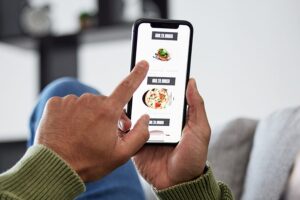Food, beverage and travel marketers, it’s time for a pop quiz.
Upon opening the app of your favorite burger spot, it prompts you to try a seasonal side you may like based on past purchases. Is this marketing?
Surprise, surprise—yes, it is!
This is an example of invisible marketing, and it’s a shift that many brands are embracing in incredibly exciting ways. The key for marketing teams to understand is that being loud is no longer the same as being remembered. In fact, today’s consumers are making it very clear that traditional advertising tactics simply aren’t cutting it. These ad-blocker stats from Backlinko offer a telling snapshot:

- Globally, an estimated 912 million internet users implement ad blocking across desktop and mobile.
- In 2024, ad blockers were forecast to cost publishers $54 billion in lost ad revenue.
Consumers continue to block, skip and even pay their way past predictable product pushes, over hyped holidays and formulaic storytelling. This aversion to old-school placements and programs has given way to invisible marketing maneuvers, such as embedded touchpoints.
An embedded touchpoint is a branded interaction that’s built into a customer’s existing behavior or environment. It’s a feature or value-add that bolsters a brand and shows up seamlessly and conveniently where consumers already are.
Food and Beverage Brands Are Digging In
Marketers are delivering smart, seamless food experiences that anticipate consumers’ cravings.
- SideChef is helping modernize online grocery shopping and giving brands the opportunity to be part of the solution.
- With SideChef’s embedded “Add to Cart” functionality, fans of Hellmann’s, Del Monte, Bertolli and Ocean Spray can quickly order ingredients from the brands’ recipe pages.
- Walmart x SideChef lets Pinterest users shop for ingredients within a series of recipes crafted specifically for the retail giant.
- The Starbucks app successfully gamifies loyalty with sticky, fun features like streaks and badge awards.
Tourism Marketers Are Hopping on Board
See how the embedded approach of invisible marketing is reshaping the way destinations connect with curious explorers.
- GuideGeek’s AI-powered travel assistant offers Instagram, WhatsApp and Messenger users itinerary suggestions for partners like Discover Greece and Tourism Richmond.
- Delta Airlines makes it easy to navigate destination cities with personalized and partner-sponsored dining and ride-share recommendations, baked right into the app experience.
- At Marriner, we’ve employed this approach with a painted rock activation for Discover Baltimore County and a live concert series supporting Visit Maryland—giving visitors real-life campaign touchpoints that blend into their journeys.
Hospitality Destinations Are Welcoming the Movement
Hotels are redefining “amenities,” blending convenience and innovation into everyday guest interactions.
- Hotel Shcani in Vienna transformed its lobby into a co-working space with ergonomic desks, meeting rooms and even a Bitcoin ATM. This transformation is branding that fits into visitors’ daily rhythms.
- Similarly, Marriott has rolled out AI-enabled private offices across 200 European locations, letting business guests save and apply lighting and temperature settings wherever they go.

Other examples include Spotify’s personalized year-in-review Wrapped program and Amazon’s Predictive AI, which aims to anticipate what customers need before they even know to ask.
But How Do You Measure What’s Invisible?
Despite the name, invisible marketing is surprisingly straightforward to measure. Doing so just looks a little different than tracking impressions and clicks. Here are the KPIs that really matter:
- Opt-in rate: What percentage of your users take the next step and engage (download app, enable notifications, join loyalty, etc.)?
- Repeat engagement rate: Are users coming back daily or weekly, not just once?
- Content-to-cart conversion: Find out how often your content is driving actual purchases.
- Percentage of wins from loyalty programs: Check your loyalty program’s impact by comparing overall sales to loyalty member sales.
- Example: Starbucks Rewards accounted for the majority of U.S. tender in 2024, proving that loyalty gamification drives direct revenue.
What This Means for Your Brand
The surge of invisible marketing proves that our industry has reached a critical and extraordinary point of evolution. It’s crystal clear that the winning brands won’t be the ones that are begging for attention. They’ll be solving problems for consumers, fitting naturally into cultural moments and designing rewarding experiences.
At Marriner, we help foodservice, hospitality and tourism brands show up for consumers in the most effective and relevant ways possible. Let’s talk about how invisible marketing can work in tandem with personalization efforts to invite a more engaged and valuable set of customers to your brand.
Sources:
“Ad Blocker Usage and Demographic Statistics,” Backlinko, September 2024.
“Make Your Recipes Shoppable: The Future of Food Commerce,” Side Chef, April 2025.
“How Shoppable Recipe Ads Are Transforming Food Advertising for CPG Brands,” Side Chef, June 2025.
“Example: How Starbucks Uses Gamification to Boost Sales,” Smartico, January 2025.
“Why hotel lobbies have become the new workplace,” Blacklane.
“7 Innovative Hotel Chains Offering Remote Work Stations for Digital Nomads in 2025,” Mighty Travels Premium, February 2025.
“The Scoop on Spotify Wrapped – Why Does it Win Every Time?” Sprinklr, December 2024.
“Amazon announces 3 AI-powered innovations to get packages to customers faster,” Amazon, June 2025.
